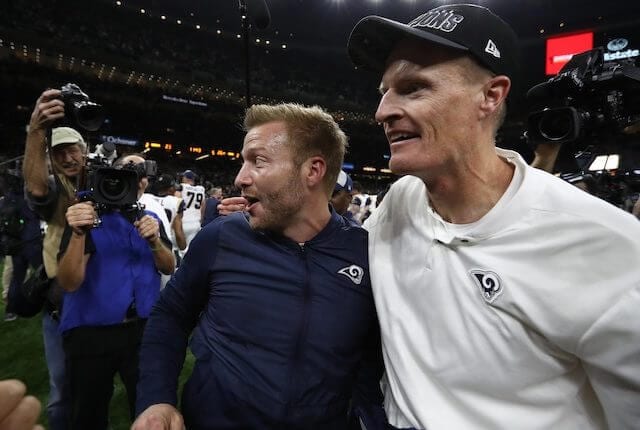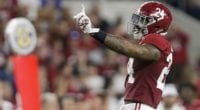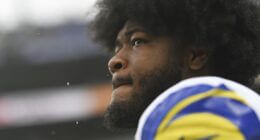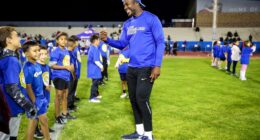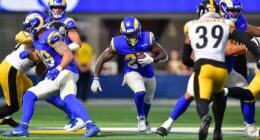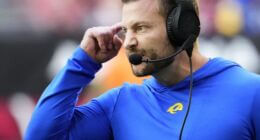Following 21 seasons in St. Louis, the NFL Rams franchise’s return to Los Angeles was met with a mix of elation from local fans and pans from pundits. The move back to California signified the first major league sports team to relocate since the NHL’s Atlanta Thrashers left Atlanta in 2011 to head north to the city of Winnipeg. However, the Rams move hasn’t just been about geographic location—it’s also about fully revitalizing the team.
Despite the fact that the Rams have 29 playoffs appearances since 1936, the only Super Bowl title the team has taken was a 1999 win during their St. Louis tenure. Nicknamed the ‘Greatest Show on Turf’ for their record-breaking offense during the 1999 season, they would win 37 of 48 games over three seasons and appear in two Super Bowls. 2003 and 2004 saw them make the playoffs, but what followed was a playoff drought which lasted 11 seasons. It wouldn’t be until the team moved to Los Angeles in 2016 that odds and moneylines for the Rams would see any much-needed momentum.
Within a number of months following the announcement of the Rams move to Los Angeles, 56,000 season ticket deposits were made and construction began on the SoFi Stadium, which is set to be complete this year. Both preceding and following this move, it was time to strategize and actively build an all-star team.
The Rams began with some strategic draft trades, working with the Tennessee Titans to help the California franchise draft quarterback Jared Goff in 2016. Later that year, the team played their first game in Los Angeles since the franchise moved to St. Louis in 1994. With record attendance at nearly 90,000 spectators, the pre-season game seemed like a good omen for the reestablished franchise, who won the game 28-24 against the Dallas Cowboys.
However, 2016 wouldn’t be the Rams’ big comeback year. Head coach Jeff Fisher was fired after the season got off to a 4-9 start, and John Fassel was brought in. By the next year, the team was playoff-ready with an 11-5 season under Fassel’s leadership. Unfortunately, they made an early exit after losing against the Atlanta Falcons with a score of 26-13.
2018 would be the year the Rams turned their franchise around, after only two seasons in their new hometown. In the off-season, the Rams were able to strategize for draft picks again, and ended up with Marcus Peters, Ndamukong Suh, Brandin Cooks, Todd Gurley, Rob Havenstein, and Aaron Donald, many of whom signed four-year contracts with the team. In the case of Aaron Donald, his six-year contract cost the team a cool $135 million, a startling number for a defensive player.
By the time playoffs came, the Rams were a favorite amongst pundits and bookmakers. Their playoff run began with a strong win of 30-22 over the Dallas Cowboys, and another win over the New Orleans Saints 26-23 meant that the Rams were heading to the Super Bowl—despite the controversial ending to their match against the Saints.
While the Rams would eventually lose the Super Bowl championship to the New England Patriots 13-3 in the lowest-scoring Super Bowl in the history of the NFL, their momentous season has left fans hopeful. After all, the team hadn’t advanced to the Super Bowl playing in Los Angeles since 1980, nor at all since their 2002 St. Louis-era run.
Draft Picks 2020
Coming off their Super Bowl defeat, the Rams have had to think long and hard about which players to trade and which to draft to perfect their strong 2018 team. After trading their first-round picks for the 2020 NFL Draft, the Rams focused their second-round options on offense.
First, they picked up running back Cam Akers, who has an explosive style of play that’s capable of changing a game. This pick was followed by wide receiver Van Jefferson, who is known for being able to make sound decisions, route himself cleanly, and stay aware of the overall movement of play. Their final addition was tight-end, Brycen Hopkins.
During their round three picks, the Rams focused on building their defense. They secured Terrell Lewis, who has incredible potential despite a history of injuries. Next came Terrell Burgess, known as a versatile safety but who also has the potential to shift positions and apply his athleticism in other positions.
Finally, the Rams picked up Jordan Fuller and Clay Johnston. Fuller is a second safety, whose reserved style of play hints that he may be a backup. Johnston is a linebacker who many speculate has been recruited for his reliability. He’s got leadership abilities, he’s productive, and he has a strong, aggressive style of play.
Kicker Sam Sloman was picked up given the fact that Rams lost their kicker Greg Zuerlein to the Dallas Cowboys. Meanwhile, guard Tremayne Anchrum was also picked up during the draft’s seventh round, though he may require a bit of time and tutelage to blossom to his full potential as part of the Rams’ defense.
Enemies Back East
While the Rams certainly have enough adoring fans in the Los Angeles area, their recent move was controversial and emotional for the city they left behind. St. Louis, Missouri was a city hellbent for an NFL franchise when they managed to attract the likes of the Los Angeles Rams in 1994. The city and its residents opened their arms to the franchise—and their wallets.
The city, county, and state-backed a $60 million domed stadium in the downtown area in order to welcome the Rams. This arena was paid for by taxpayers, and, to this day, the dome hasn’t been fully repaid despite the fact that it was retired following the Rams departure in 2015.
Despite the team’s impressive run under all-star quarterback Kurt Warner in the late 90s and early 2000s, the Rams didn’t have the chops to maintain their impressive run following the 1999 Super Bowl win. And, despite St. Louis’s attempt to entice the Rams to stay by proposing a $1.1 billion riverfront stadium (with $400 million supposed to come from taxpayers), owner Stan Kroenke declined.
The team moved and left behind financial debt for Missouri taxpayers, as well as emotional pain. The franchise left because it wasn’t making money, but locals felt that they’d already paid enough to relocate the team and viewed the Rams as a public franchise. Mistakes that misled the Rams once top-performing team couldn’t be blamed or billed to local residents, and, despite the fact that the blame falls squarely on owner Stan Kroenke, the vitriol was flung toward the West Coast.
Needless to say, many St. Louis residents were rooting for the Patriots during the Rams 2018 Super Bowl run.
